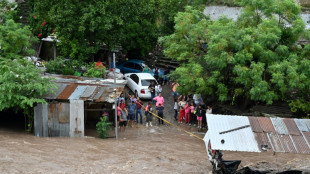
-
 Texans cruise as Cowboys crisis deepens
Texans cruise as Cowboys crisis deepens
-
Do the Donald! Trump dance takes US sport by storm

-
 Home hero Cameron Smith desperate for first win of 2024 at Australian PGA
Home hero Cameron Smith desperate for first win of 2024 at Australian PGA
-
Team Trump assails Biden decision on missiles for Ukraine

-
 Hong Kong court jails 45 democracy campaigners on subversion charges
Hong Kong court jails 45 democracy campaigners on subversion charges
-
Several children injured in car crash at central China school

-
 Urban mosquito sparks malaria surge in East Africa
Urban mosquito sparks malaria surge in East Africa
-
Djibouti experiments with GM mosquito against malaria

-
 Pulisic at the double as USA cruise past Jamaica
Pulisic at the double as USA cruise past Jamaica
-
Many children injured after car crashes at central China school: state media

-
 Asian markets rally after US bounce as Nvidia comes into focus
Asian markets rally after US bounce as Nvidia comes into focus
-
Tens of thousands march in New Zealand Maori rights protest

-
 Five takeaways from the G20 summit in Rio
Five takeaways from the G20 summit in Rio
-
China, Russia ministers discuss Korea tensions at G20: state media

-
 Kohli form, opening woes dog India ahead of Australia Test series
Kohli form, opening woes dog India ahead of Australia Test series
-
Parts of Great Barrier Reef suffer highest coral mortality on record

-
 Defiant Lebanese harvest olives in the shadow of war
Defiant Lebanese harvest olives in the shadow of war
-
Russian delegations visit Pyongyang as Ukraine war deepens ties

-
 S.Africa offers a lesson on how not to shut down a coal plant
S.Africa offers a lesson on how not to shut down a coal plant
-
Italy beat Swiatek's Poland to reach BJK Cup final

-
 Japan, UK to hold regular economic security talks
Japan, UK to hold regular economic security talks
-
Divided G20 fails to agree on climate, Ukraine

-
 Can the Trump-Musk 'bromance' last?
Can the Trump-Musk 'bromance' last?
-
US to call for Google to sell Chrome browser: report

-
 Macron hails 'good' US decision on Ukraine missiles
Macron hails 'good' US decision on Ukraine missiles
-
Italy eliminate Swiatek's Poland to reach BJK Cup final

-
 Trump expected to attend next Starship rocket launch: reports
Trump expected to attend next Starship rocket launch: reports
-
Israeli strike on Beirut kills 5 as deadly rocket fire hits Israel

-
 Gvardiol steals in to ensure Croatia reach Nations League quarter-finals
Gvardiol steals in to ensure Croatia reach Nations League quarter-finals
-
Thousands march to New Zealand's parliament in Maori rights protest

-
 China's Xi urges G20 to help 'cool' Ukraine crisis
China's Xi urges G20 to help 'cool' Ukraine crisis
-
Church and state clash over entry fee for Paris's Notre Dame

-
 Holders Spain strike late to beat Switzerland in Nations League
Holders Spain strike late to beat Switzerland in Nations League
-
Stocks, dollar hesitant as traders brace for Nvidia earnings

-
 Swiatek saves Poland against Italy in BJK Cup semi, forces doubles decider
Swiatek saves Poland against Italy in BJK Cup semi, forces doubles decider
-
Biden in 'historic' pledge for poor nations ahead of Trump return

-
 Sudan, Benin qualify, heartbreak for Rwanda after shocking Nigeria
Sudan, Benin qualify, heartbreak for Rwanda after shocking Nigeria
-
Five dead in new Israeli strike on Beirut's centre

-
 Where's Joe? G20 leaders have group photo without Biden
Where's Joe? G20 leaders have group photo without Biden
-
US permission to fire missiles on Russia no game-changer: experts

-
 Tropical storm Sara kills four in Honduras and Nicaragua
Tropical storm Sara kills four in Honduras and Nicaragua
-
Germany, Finland warn of 'hybrid warfare' after sea cable cut

-
 Spanish resort to ban new holiday flats in 43 neighbourhoods
Spanish resort to ban new holiday flats in 43 neighbourhoods
-
Hong Kong to sentence dozens of democracy campaigners

-
 Russian extradited to US from SKorea to face ransomware charges
Russian extradited to US from SKorea to face ransomware charges
-
Phone documentary details Afghan women's struggle under Taliban govt

-
 G20 wrestles with wars, 'turbulence' in run-up to Trump
G20 wrestles with wars, 'turbulence' in run-up to Trump
-
Kane hoping to extend England career beyond 2026 World Cup

-
 Gazans rebuild homes from rubble in preparation for winter
Gazans rebuild homes from rubble in preparation for winter
-
'Vague' net zero rules threaten climate targets, scientists warn


UN forecasts La Nina could help lower temperatures this year
The return of the cooling La Nina weather phenomenon this year should help lower temperatures somewhat after months of global heat records, the United Nations' weather agency said Monday.
The impact is likely to be felt in the next few months because the warming El Nino weather pattern -- which has helped fuel a spike in global temperatures and extreme weather around the world since mid-2023 -- "is showing signs of ending", the UN's World Meteorological Organization said in its latest update.
The WMO warned, however, that global temperatures would continue to rise in the long term due to human-induced climate change, which continues to make extreme weather worse and upend seasonal rainfall and temperature patterns.
La Nina refers to the cooling of the ocean surface temperatures in large swathes of the tropical Pacific Ocean, coupled with winds, rains and changes in atmospheric pressure.
In many locations, especially in the tropics, La Nina produces the opposite climate impacts to El Nino, which heats up the surface of the oceans, leading to drought in some parts of the world and triggering heavy downpours elsewhere.
The WMO said there was a "60 percent" chance of La Nina conditions in the period from July to September and a "70 percent" likelihood during August-November.
The chances of El Nino redeveloping are negligible, it added.
Every month since June 2023, when El Nino returned, has set a new high temperature record, and 2023 was by far the warmest year on record globally.
The WMO said the planet would continue to heat up overall from the use of fossil fuels that produce greenhouse gases.
- Man-made global heating -
"The end of El Nino does not mean a pause in long-term climate change, as our planet will continue to warm due to heat-trapping greenhouse gases," WMO deputy secretary general Ko Barrett stressed.
"Exceptionally high sea surface temperatures will continue to play an important role during next months."
Much of the planet's excess heat from climate change is stored in the oceans.
In the United States, the National Oceanic and Atmospheric Administration has already factored the expected La Nina into its forecasts for this year's Atlantic hurricane season.
The NOAA said it expected four to seven major hurricanes in the Atlantic between June and November.
"The upcoming Atlantic hurricane season is expected to have above-normal activity due to a confluence of factors, including near-record warm ocean temperatures in the Atlantic Ocean, development of La Nina conditions in the Pacific, reduced Atlantic trade winds and less wind shear," the NOAA said on May 23.
The WMO noted that the past nine years had been the warmest on record, even with the cooling influence of a La Nina event that lasted from 2020 to early 2023.
The latest El Nino, which peaked in December, was one of the five strongest on record.
"Our weather will continue to be more extreme because of the extra heat and moisture in our atmosphere," Barrett said.
The WMO has made it a priority to ensure that all regions of the world are covered by early warning systems by 2027, particularly the least well-equipped, such as Africa.
"Seasonal forecasts for El Nino and La Nina, and the anticipated impacts on the climate patterns globally, are an important tool to inform early warnings and early action," Barrett said.
D.Lopez--AT



